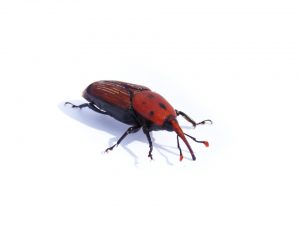What are Food Beetles?
Food (or pantry) beetles can refer to any large group of beetles that infest stored items in commercial and residential settings. Though there are many types of food beetles, they are grouped into four categories based on their feeding habits. Internal feeders are rice weevils, granary weevils, and lesser grain borers. External feeders are the beetle types that complete their life cycle outside of the grain. Some of these are cigarette beetles, drugstore beetles, cabinet, and warehouse beetles.

Weevils are internal feeders.
Secondary feeder beetles and bugs include mealworms, spider beetles, and foreign grain beetles. Lastly, scavengers include red flour beetle and saw-toothed grain beetle. Infestations happen when either contaminated grains or products have been processed and are introduced to a home, plant, or facility.
Frequented Areas
Geographically, food beetles are thought to have originated in Africa and now maintain a presence throughout the entire United States, mostly in raw agricultural commodities and then may be transported when harvested.
Food beetles may infest any area that contains food including personal pantries, commercial warehouses, as well as food in stores. These pests invade a variety of foods including rice, beans, grains, oats, and flour. Secondary feeders are the only ones of the bunch that feeds on the result of a spoiled product.
This includes mold on something or a leftover rodent bait which is often found in an attic, bringing to light the fact that a pantry or food storage area may not be the only place in a home to check for an infestation.
Identification and Physical Characteristics
All of these pests are visible to the naked eye and can be seen in any of their life stages. The larvae may look slightly similar to a grain of rice, but all contaminated food should be disposed of when a beetle is found. The easy to identify weevils have a long snout with a functional mouth part that comes from their head. Saw-toothed grain beetles are fairly thin and black, while red flour beetles, drugstore beetles, and cigarette beetles are more of an oval shape and brown in color. Mealworms are light brown but are easy to identify in an infested product, as they are not small in size. Spider beetles are relatively small but have a teardrop-shaped body that is dark brown.
Special Characteristics
These types of infestations are not seasonal and can happen at any given time when the bugs are introduced to a home or warehouse. Pantry beetles of different species do have different habitats, behaviors, and diets.Pests may be found anywhere from an unopened package from a store, to a forgotten spill in a cabinet.
Removal and Preventative Procedures
Prevention of these beetles can be simple when exercised before a problem begins. At the first sight of an infestation, a pest control professional should be contacted immediately. They will be able to correctly identify the pest and put together a plan of action to eliminate it. This includes checking any other areas or products that the pest has infested. You should also examine food packages at the store to ensure that you are not purchasing goods that may be damaged. Both adult and larval insect stages may be infesting products, so be on the lookout for both. Use products from your pantry before they expire or get old, using products that were bought first before newer purchased products. Buying in smaller quantities ensures that products are used before they get old.

Commercial granaries are not immune to food beetles.
Keeping the pantry clean and organized will help the owner easily identify messy spills that might attract pests. Vacuuming any spilled sugar, flour, or grains is as easy way to ensure that they are not attracting bugs, but be sure to discard what was vacuumed up, if any beetles were in there, they will create an infestation inside of the vacuum bag. Glass or plastic containers with lids that fit tight are the most practical, while cardboard, wood, and paper containers can fuel an infestation.
Application of Chemicals and Electronic Removal
Homeowners should leave insecticides to the professionals. These trained individuals will come to correctly identify the pest, as well as let the homeowner know which items are contaminated, and then they will treat as needed. The professionals will treat in a way that will not risk contaminating other food or products with insecticides.


No Comments